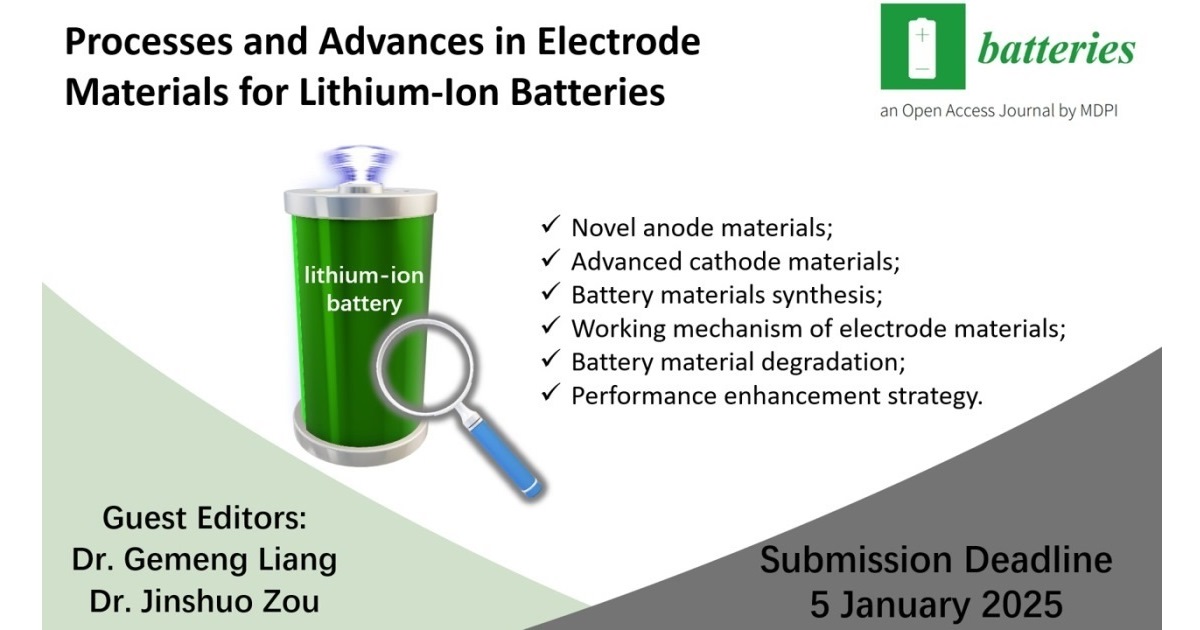- 4.8Impact Factor
- 6.6CiteScore
- 19 daysTime to First Decision
Processes and Advances in Electrode Materials for Lithium-Ion Batteries
This special issue belongs to the section “Battery Materials and Interfaces: Anode, Cathode, Separators and Electrolytes or Others“.
Special Issue Information
Dear Colleagues,
Lithium-ion batteries are ubiquitous in today’s world and have changed the way that we live since their first commercialization in the 1990s. The development of lithium-ion batteries relies on the advancement of high-performance active materials for batteries. This Special Issue will focus on the recent advances in electrode materials for lithium-ion batteries, aiming to highlight the latest breakthroughs in material science, improve battery efficiency, and promote sustainable energy storage solutions.
This Special Issue will provide a comprehensive overview of cutting-edge research that drives the evolution of lithium-ion battery technology and supports the transition to cleaner energy systems.
Topics covered by this Special Issue include but are not limited to the following:
- Novel anode materials;
- Advanced cathode materials;
- Battery materials synthesis;
- Working mechanism of electrode materials ;
- Battery material degradation;
- Performance enhancement strategy.
Dr. Gemeng Liang
Dr. Jinshuo Zou
Guest Editors
Manuscript Submission Information
Manuscripts should be submitted online at www.mdpi.com by registering and logging in to this website. Once you are registered, click here to go to the submission form. Manuscripts can be submitted until the deadline. All submissions that pass pre-check are peer-reviewed. Accepted papers will be published continuously in the journal (as soon as accepted) and will be listed together on the special issue website. Research articles, review articles as well as short communications are invited. For planned papers, a title and short abstract (about 250 words) can be sent to the Editorial Office for assessment.
Submitted manuscripts should not have been published previously, nor be under consideration for publication elsewhere (except conference proceedings papers). All manuscripts are thoroughly refereed through a single-blind peer-review process. A guide for authors and other relevant information for submission of manuscripts is available on the Instructions for Authors page. Batteries is an international peer-reviewed open access monthly journal published by MDPI.
Please visit the Instructions for Authors page before submitting a manuscript. The Article Processing Charge (APC) for publication in this open access journal is 2700 CHF (Swiss Francs). Submitted papers should be well formatted and use good English. Authors may use MDPI's English editing service prior to publication or during author revisions.
Keywords
- electric vehicles
- lithium-ion battery
- anode materials
- cathode materials
- characterization techniques
- modification techniques
- scaling up and commercialization

Benefits of Publishing in a Special Issue
- Ease of navigation: Grouping papers by topic helps scholars navigate broad scope journals more efficiently.
- Greater discoverability: Special Issues support the reach and impact of scientific research. Articles in Special Issues are more discoverable and cited more frequently.
- Expansion of research network: Special Issues facilitate connections among authors, fostering scientific collaborations.
- External promotion: Articles in Special Issues are often promoted through the journal's social media, increasing their visibility.
- e-Book format: Special Issues with more than 10 articles can be published as dedicated e-books, ensuring wide and rapid dissemination.

